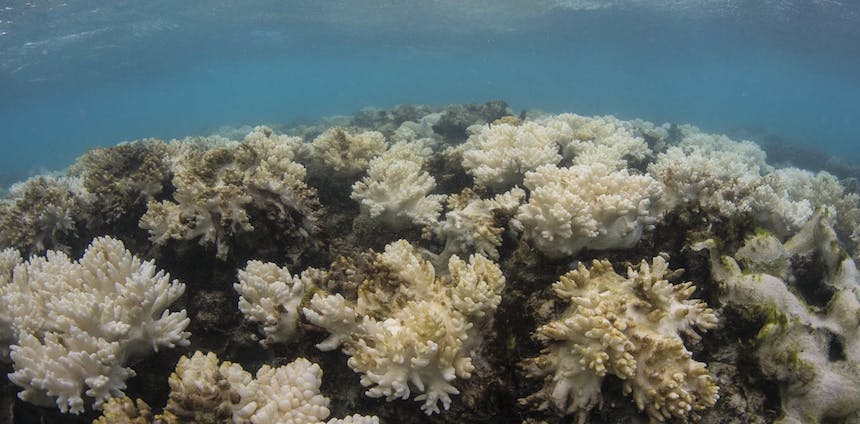 It is no longer news that the Great Barrier Reef has suffered extreme bleaching.
It is no longer news that the Great Barrier Reef has suffered extreme bleaching.
In early 2016, we heard that the reef had suffered the worst bleaching ever recorded. Surveys published in June that year estimated that 93% of coral on the vast northern section of the reef was bleached, and 22% had already been killed.
Further reports from this year show that bleaching again occurred. The back-to-back bleaching hit more than two-thirds of the Great Barrier Reef and may threaten its UNESCO World Heritage listing.
After recent years of damage, what does the future hold for our priceless reef?
Our new research, published in the Bulletin of the American Meteorological Society’s special report on climate extremes, shows the news isn’t good for the Great Barrier Reef’s future.
Coral reefs are complex ecosystems that are affected by many factors. Changes in sea surface temperatures, rainfall, cloudiness, agricultural runoff, or water quality can affect a reef’s health and resilience to stress.
Early analysis of the 2016 bleaching suggested that the Great Barrier Reef was suffering from thermal stress brought on by human-caused climate change.
Our study took a new and comprehensive approach to examine these multiple climatic and environmental influences.
We set out to answer the crucial question: could anything else have bleached the Great Barrier Reef, besides human-induced climate change?
Clear fingerprint
The results were clear. Using a suite of climate models, we found that the significant warming of the Coral Sea region was likely caused by greenhouse gases from human activities. This warming was the primary cause of the extreme 2016 bleaching episode.
But what about those other complex factors? The 2016 event coincided with an El Niño episode that was among the most severe ever observed. The El Niño-Southern Oscillation system, with its positive El Niño and negative La Niña phases, has been linked to bleaching of various coral reefs in the past.
Our study showed that although the 2016 El Niño probably also contributed to the bleaching, this was a secondary contributor to the corals’ thermal stress. The major factor was the increase in temperatures because of climate change.
We next analysed other environmental data. Previous research has found that corals at sites with better water quality (that is, lower concentrations of pollution particles) are more resilient and less prone to bleaching.
Pollution data used in our study show that water quality in 2016 may have been better than in previous bleaching years. This means that the Great Barrier Reef should have been at lower risk of bleaching compared to long-term average conditions, all else being equal. Instead, record bleaching hit the reef as a result of the warming temperature trend.
Previous events
The final part of our investigation involved comparing the conditions behind the record 2016 bleaching with those seen in previous mass bleaching episodes on the Great Barrier Reef, in 1997-98 and 2010-11.
When we analysed these previous events on the Reef, we found very different factors at play.
In 1997-98 the bleaching coincided with a very strong El Niño event. Although an El Niño event also occurred in 2016, the two were very different in terms of the distribution of unusually warm waters, particularly in the eastern equatorial Pacific. In 1997-98, the primary cause of the bleaching – which was less severe than in 2016 – was El Niño.
In 2010-11, the health of the Great Barrier Reef was impaired by runoff. That summer brought record high rainfall to eastern Australia, causing widespread flooding across Queensland. As a result of the discharge of freshwater onto the reef reducing the salinity, bleaching occurred.
There have been many reports in recent years warning of trouble for the Great Barrier Reef. Sadly, our study is yet another warning about the reef’s future – perhaps the most comprehensive warning yet. It tells us that the 2016 bleaching differed from previous mass bleaching events because it was driven primarily by human-induced climate warming.
This puts the Great Barrier Reef in grave danger of future bleaching from further greenhouse warming. The local environmental factors that have previously helped to protect our reefs, such as good water quality, will become less and less able to safeguard corals as the oceans warm.
![]() Now we need to take immediate action to reduce greenhouse gas emissions and limit further warming. Without these steps, there is simply no future for our Great Barrier Reef.
Now we need to take immediate action to reduce greenhouse gas emissions and limit further warming. Without these steps, there is simply no future for our Great Barrier Reef.
Sophie Lewis, Research fellow, Australian National University and Jennie Mallela, Research Fellow in Coral Reef Monitoring and Reef Health Appraisal, Australian National University
This article was originally published on The Conversation. Read the original article.

